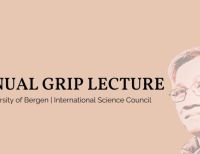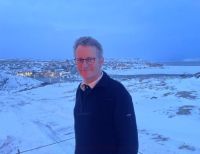“My research is based on the knowledge gaps we have of the deep sea. These knowledge gaps prevent us from establishing management measures that are effective. These knowledge gaps are well identified. We know what they’re about. It's about the biodiversity, mapping of the different habitats. But also understanding the ecology of this ecosystem, how the different species interact with the environment. And a level above, understanding potential impacts of any drilling operations in the deep sea,” says Pedro Ribeiro from the Centre for Deep Sea Research at the University of Bergen (UiB).
- Thursday 26 October there is a debate on deep-sea mining at Kulturhuset in Bergen, with Pedro Ribeiro as one of the speakers.
The deep-sea scientist is concerned that we are moving too fast when it comes to exploring the natural resources of the Arctic seas north of Norway. This worry is shared by many after Norway’s government presented a paper to the Norwegian parliament Stortinget in June 2023 to open for increased exploration and potentially exploitation of the seabed in the Arctic. A hearing on this paper will be at Stortinget on 26 October 2023.
“We are currently generating data and analysis that can inform about these gaps and clarify some of our doubts. We are collaborating with colleagues at the University of Stavanger on a risk framework. Which is a formal way for any industry to address environmental risk. To identify the sources of risk. And to the extent that we can quantify the amount of risk in any operation. Towards biodiversity. Towards, for instance, connectivity. Towards certain...,” he fades off before gathering his thoughts:
“There's a source of risk and there's a potential consequence. This environmental risk framework has been used, for instance, in oil and gas for many years. So, it's something that can and should be implemented for deep-sea mining as well.”
Before continuing about deep-sea mining and Ribeiro’s current research, let’s take a step back and look at his early career and research leading up to him arriving in Bergen.
After graduating with a PhD from the University of Southampton, hosting one of the world’s leading deep sea science environments, Ribeiro applied for an individual postdoctoral fellowship in his native Portugal and moved to the University of the Azores in 2009.
“I've been involved both in European and national projects in deep-sea ecology, but also deep-sea mining. I was part of two of the largest projects that came in the beginning about deep-sea mining, the MIDAS projectand JPI Oceans MiningImpact,” he says.
In 2017, a series of fortunate events led him to Bergen and UiB when he got involved in the EU funded Horizon 2020 project SponGES (2016-2021), which investigated North Atlantic sponge grounds to advance ecological, biomedical and management knowledge of these important deep-sea habitats.
“I'm grateful that I got this job and after a while I got more involved with the Centre for Deep Sea Research and participating in their research cruises. Now I'm fully involved in what the centre is doing in terms of deep-sea research in the Arctic region. Including this really hot topic of deep-sea mining,” says Ribeiro.
Quickly establishing himself as a name to watch in the international deep-sea research environment in Bergen, the Portuguese now leads the Eco-Safe Ridge Mining project funded by the Research Council of Norway.
“Eco-Safe is a three-year project that will get to a certain extent at identifying some of the deep-sea knowledge gaps,” says Ribeiro, “but these huge gaps cannot be covered by a project like Eco-Safe alone. Which has a limited budget and a limited team. I mean we are a very good team, but we don't cover all the aspects.”
With the project addressing the priority knowledge gaps it complements what the Centre for Deep Sea Research has been doing in recent years. But Eco-Safe also goes a little bit further…
“For example, we are now investigating part of the trophic ecology of the animals down there, with a focus on species inhabiting inactive vents and the surrounding area. This is something that we have not addressed before. We are also looking at characterizing benthic habitats and community structure in the deep-sea through imagery, using video recorded with the remotely operated vehicle (ROV), Ægir6000. We have collected quite a lot of imagery over the years and are collecting more because we are visiting new sites every year.”
Above all, Ribeiro and his team are examining the imagery.
“We are annotating the images and doing the statistical analysis to understand the community structure at hydrothermal vents, but also at seamounts, because seamounts are where manganese crusts occur. We don't hear a lot about manganese crusts. That's a bad sign. Because ... there is a consensus that active vents should not be mined. First because it's dangerous for operations but also because they really are a very special and very rare ecosystem. But then you have the other mineral resource, manganese crusts, which also coexist with vulnerable deep-sea habitats, in particular Arctic sponge grounds. And there is a lot of resource assessment targeting manganese crusts now.”
He gets into detail describing what is at stake.
“There is now a lot of research going into these seamounts. Looking at the bathymetry and identifying areas of steep slopes. And there is a prediction that there will be manganese crusts there. Because that's where this type of mineral precipitates. And then this is explored by cutting a slice and checking the thickness of this manganese crust and mineral composition. That's actually a very, very serious candidate for being the prime target for seabed mining in Norway. Not the sulphides in the active vents. Those I don't think will be mined. That would be really bad. Instead, the extinct deposits that are buried under many meters of sediment may be targeted, but they are difficult to detect using current technology.”
He returns to the key topic of the current knowledge gaps when it comes to the deep sea and assessing the consequences of activity in these fragile waters without acquiring more scientific knowledge.
“We must predict the consequences in a way that is scientific, which means not only to predict that there will be a negative impact. But to quantify that negative impact. To know exactly, for instance, how many species will be threatened. Or how much the abundance of certain species or the extent of a marine community will be affected. This is the difficult part because we need a quantification.”
He gives an example of how little knowledge we have at present.
“When we go to these deep-sea areas, we see what lives there. We see the species. The ones we can see through imagery, we know them. Some of them have not been... How should I explain this? Some of them we know that they are there, we have seen them. But they have not been described scientifically. Some species, for instance, they look the same. And when we bring them to the lab and we do more careful examination, we realize that they are separate species,” he explains.
He uses the term masked biodiversity (aka cryptic biodiversity) to explain this, which is a way of saying that what may look like one species may in fact be more.
“You have this kind of, not hidden, but masked biodiversity. So, we are at that level where we are still collecting and examining samples. Especially from the smaller fauna that cannot be identified from images. To understand exactly how many species are there. And then the next step is to describe them scientifically. And of course, if you want to monitor biodiversity, you need to know what biodiversity you are monitoring. Imagine that you observe one species on video. You think from the way it looks that it's one species and then examining closely you realize it's not one, it's five or six. This obviously changes our perspective of how much biodiversity is being potentially disturbed by an activity.”
According to Ribeiro, his team as well as the Centre for Deep Sea Research at UiB are now taking steps towards putting sensors and observatories in the deep sea.
“This way we can record the environment continuously. So that we can understand this natural fluctuation. Currently we only have snapshots of deep-sea life. But what we don't have is the continuum. How do the animals or the life move around? How do the numbers change naturally? If you understand how they change naturally then you can predict, or you identify how they change due to disturbance. Otherwise, you don't know.”
He compares the pioneer work his group is doing to what was done in fisheries research some years ago.
“Thanks to this monitoring we know quite a lot about how certain fish species move around in the ocean. And how that also is changing with global warming,” he says briefly pausing before continuing:
“How many years of fisheries monitoring have been carried out continuously? Every year we have these cruises that monitor certain species, certain stocks. To understand the natural dynamics of these populations. How many years were needed to be able to track this? It took quite a few years to understand. And even then, there will still be things that are not understood.”
So, you'll be conducting something similar in the deep sea?
“Yes, and in very specific locations. Because it's very difficult for benthic studies. The technology and resources we have right now do not allow us to have a widespread geographical coverage over time. And I mean not just the University of Bergen, I mean globally. So, we must at this stage pick our spots.”
One key feature to get the science disseminated to a both policymakers and a broader audience is the use of visuals/visualisation.
“The deep sea is so exotic. It's something that is so strange. And the common person, the general public is not even aware that these habitats, these creatures exist. But I find that whenever we succeed in showing them what is down there and bringing these spectacular images of these very strange creatures, very fragile creatures to the public, they are fascinated.”
He points to the Centre of Deep Sea Research’s underwater exploration system including the ROV Ægir 6000.
“It has been upgraded in terms of the camera that it carries. This helps showing the public what kind of animals we are talking about. We need a good imagery system. So, we use imagery all the time for the science. We try to take the best possible images in sometimes challenging environments. That can show the diversity of habitats, diversity of fauna. Sometimes we have surprises, sometimes we have something swimming across the camera. And then we stop everything. We stop all operations, and we just focus on that one. Because I think for the deep-sea mining debate it is really important that we show the public that the deep sea used to be far from sight, but not anymore. We can show them what is out there.”
Ribeiro says that whenever he shows images of life in the deep sea, there usually is a positive reaction with people exclaiming ‘I had no idea that we had this in our waters’. He believes it’s important to preserve or at least to understand that if we create a new activity, a new industry in the deeps of the sea, that this is done carefully.
“Because we have all these fragile animals living down there. But if we don't do our job correctly, this message will not come out. We need to generate interest from the public and have help from media to create these stories to generate interest.”
He shows a photo of Dumbo octopus, one of many iconic images he and his team have gathered in Norwegian waters.
“I think that people need to see these things to get some understanding. I can try to explain why they are so beautiful and so precious but if you see a Dumbo octopus swimming, if you show them that, that makes a big difference.”
To underline his point, he mentions a story about deep sea mining in Germany.
“Germany has a licensed area in the Pacific in the Clarion-Clipperton Zone (CCZ), where you have vast amounts of polymetallic nodules. That's one of the areas where we predict that deep-sea mining might start earlier. And the public opinion in Germany was always very split. You had these people who wanted to preserve the ecosystem and say, well, we don't need these minerals. You need to stop right away. But there was always a debate until one day, one cruise came back with images of this octopus mom. Standing on top of a stalk in the deep sea, like alone and nursing some eggs. Like a mom, the mama octopus. And the power of that image was such that it started a movement leading to Germany’s deciding for a moratorium on deep-sea mining. So that's the power of images and the power of selecting the images that can make a big difference.”
The power of images may become important in Norway now as well. With the debate heating up after the government’s proposal to open for more exploration of the deep sea.
You were talking about the research gaps that exist. How much of this information that you have gathered do you get across to policymakers?
“The Centre for Deep Sea Research has been active and has been conducting important research for many years. We are one of the very few institutions that investigates the deep sea in that area. We publish our papers; we publish our work. But as you say, it’s also important to bridge the gap to policymakers,” says Ribeiro who believes the scientific community still has some way to go on the science-policy nexus.
“We usually have contact with policymakers when they request our feedback. And this happens very often during hearing consultation processes. Sometimes we get a request from the government to give feedback directly on the impact assessment and on the knowledge base. But now at this stage of the process, sometimes we get requests to go to the parliament and explain why we think it should be like this and not like that. Or just to give general information. It’s vital to have access to the people in this country who actually make the political decisions.”
There is much discussion on a deep-sea mining moratorium and to get the scientific knowledge first. How many years do you think it will be until we know enough to evaluate this?
“I get asked this question so often. And in the beginning, I was very optimistic, and I would give a number. You really don't know because it's a relationship. It's directly related to the number of scientists and resources that you put into it. You have data gathering. And for that, I would say that the more investment you put into collecting data, the more data you get. But you still need a certain amount of time to understand the natural variability of the system. So, you still need a few years of continuous data series to be able to characterise the system you are investigating. Take, for instance, climate studies, one cannot characterise the climate pattern in a certain region by only recording data during a brief period of time.”
He pauses.
“And when you have the data: how do you analyse this data? You need human resources. Without human resources, without expertise, without scientists, you cannot really accelerate too much. So, I can give you a number in terms if we put together a research programme that is ambitious with the necessary resources in place, with a team of scientists that know the system, and adequate means to collect and analyse scientific data, within 10 years, we will be able to answer many of the relevant questions for a well-informed decision. But we also understand that we will never know everything.”
How does he view the government’s proposal to open for deep-sea mining from a scientific point of view?
“It all depends on how it's going to be done. And right now, we don't know how it's going to be done. It is not possible to know at this point if commercial mining can take place without serious and permanent damage to the ecosystem. Together with a resource assessment, there was an environmental impact assessment which was largely inconclusive due to the prevailing knowledge gaps. If mineral exploration starts, I believe that it is mandatory to have a framework in place, establishing, among other things, which areas are strictly excluded from exploration based on conservation values, not just related to active vents but also seamounts. What is the sequence of operations? What kind of equipment can be used for this exploration? It should follow the guidelines of scientific exploration, should follow the same code of conduct that scientists use, for example to only take the number of samples that we think are needed. If exploration follows a code of conduct that is in line with scientific research methods, potential harm coming from that activity can be minimised. This framework must be defined from the start before any exploration licenses are attributed. I also believe that if we are to have an impact assessment or monitoring of exploration activities, this needs to be done by independent research institutions.
Yet he believes that key questions remain before moving into further exploration of the Arctic deep sea.
“How can you monitor impacts in an environment that you don't understand well? What are you going to measure, and what level of environmental disturbance from deep-sea mining should be considered acceptable?”














